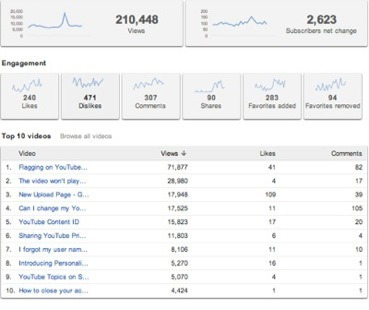 While it makes sense to look at clicks and conversions when it comes to your video advertising campaign on YouTube, you’ll also want to take a look at their Analytics section from time to time. The data they’re providing is based on their understanding of your traffic and its behavior when your video is viewed. Before you put down a chunk of change on an explainer video or hire a spokesperson, you’ll want to have a good handle on how people are consuming your content and how to improve your communication when necessary.
While it makes sense to look at clicks and conversions when it comes to your video advertising campaign on YouTube, you’ll also want to take a look at their Analytics section from time to time. The data they’re providing is based on their understanding of your traffic and its behavior when your video is viewed. Before you put down a chunk of change on an explainer video or hire a spokesperson, you’ll want to have a good handle on how people are consuming your content and how to improve your communication when necessary.
You’ll find the Analytics section of your channel inside of your Video Manager on the left side navigation, under the Channel Setting, and over the Creation Tools. Opening the Analytics navigation gives you a smorgasbord of data including YouTube’s analysis of your demographics, playback locations, traffic sources, devices used, and audience retention. You can organize the reports by any number of time periods including the last 30 days, up to the last calendar year.
So how can you quickly gather a picture of how your video is doing and whether or not it needs to be improved? First and foremost, you’ll want to go to the audience retention section of Analytics. Find out if people are sticking around until they hear your call to action, or if they are clicking away as soon as they get to the video. The audience retention analysis will tell you on average how long people watch into your video and at what point they’re leaving.
While you’ll be dictating who sees your video ad based on the parameters you set, you’ll want to make sure to verify what’s actually happening against the demographics section. Who is actually viewing your video? Is it consistent with your customer avatar? Is it consistent with how your ad is structured? Is it consistent with how you tailored your advertisement?
For some, it may be helpful to go one step farther to find out where people are watching the video. Are they seeing it on the YouTube watch page, or as an embedded video on other websites? YouTube provides interesting data in this section; you can tell how long on average people will watch the video, depending on what playback location they’re using. This knowledge can be especially helpful as you enter the second round with your ad and begin to test and tweak it.
You should use the data from Analytics as a guideline only; it shouldn’t determine everything that you do, nor should it dictate the changes you make as you move forward. However, when your ad isn’t performing the way that you think it should, YouTube Analytics can provide a fresh perspective.



